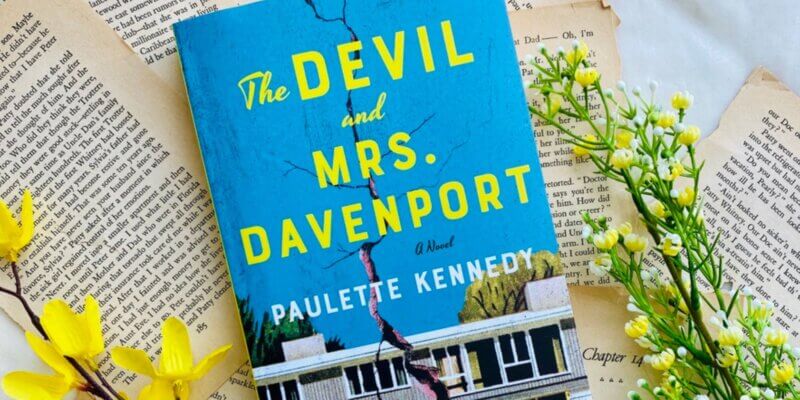Welcome back, friend! Yesterday, I shared about The Devil and Mrs Davenport, a gothic novel set in the 1950s. The main character is housewife who develops psychic abilities after a viral illness. Today, I am excited to bring you this interview with Paulette Kennedy! 🙂

The Devil and Mrs Davenport
The bestselling author of The Witch of Tin Mountain and Parting the Veil mines the subtle horrors of 1950s America in a gripping novel about a woman under pressure—from the living and the dead.
The first day of autumn brought the fever, and with the fever came the voices.
Missouri, 1955. Loretta Davenport has led an isolated life as a young mother and a wife to Pete, an ambitious assistant professor at a Bible college. They’re the picture of domestic tranquillity—until a local girl is murdered and Loretta begins receiving messages from beyond. Pete dismisses them as delusions of a fevered female imagination. Loretta knows they’re real—and frightening. Defying Pete’s demands, Loretta finds an encouraging supporter in parapsychologist Dr. Curtis Hansen. He sees a woman with a rare gift, more blessing than curse.
With Dr. Hansen’s help, Loretta’s life opens up to an empowering new purpose. But for Pete, the God-fearing image he’s worked so hard to cultivate is under threat. No longer in control of his dutiful wife, he sees the Devil at work. As Loretta’s powers grow stronger and the pleading spirits beckon, Pete is determined to deliver his wife from evil. To solve the mysteries of the dead, Loretta must first save herself.
Get to know the author: Paulette Kennedy
Hi Paulette! It is a pleasure to have you on Armed with A Book. Please tell me and my readers a bit about yourself.

Thanks for having me! I’m an author of historical gothic fiction who has a love for all things darkly romantic and atmospheric. The Devil and Mrs. Davenport is my third novel.
The Devil and Mrs Davenport is set in the 1950s. What inspired you to choose this time period for your book?
There were lots of reasons I chose the 1950s for my setting, but mostly I chose it because it was a period of transition for women. During mid-century, women were increasingly examining their role in society and many of their frustrations became catalysts for the women’s rights movement. They’d gone from a period of relative self-sufficiency during World War 2, to being pushed back into domestic life once their husbands returned home from the war. Women went from having very few autonomous rights in the ‘50s to being able to be fully independent by the 1970s. We have our grandmothers and great-grandmothers to thank for that—women just like Loretta.
How did you approach the portrayal of Loretta’s supernatural abilities?
As far as how Loretta communicates with the spirits of the dead, I did a lot of research on mediums and how psychic abilities manifest in people who claim to have these abilities. Loretta’s psychic abilities are also a metaphor for her coming-of-age, her growing self-esteem, and her awakening as a woman ready to discover who she really is and who she wants to become.
Parapsychologist Dr. Curtis Hansen plays a supportive role in Loretta’s journey. What inspired his character, and how does he contribute to Loretta’s empowerment?
Dr. Hansen was inspired by J.B. Rhine, and also Hans Holzer, two pioneering scientists in the field of metaphysics, but there’s also a little bit of Fox Mulder there, too—as far as his intellectual curiosity and his open-minded pursuit of the truth. I think he helps contribute to Loretta’s empowerment by being the first person to really respect her, listen to her, and validate her abilities as well as her feelings. I’ve been criticized for not having any good men in my books, and while that is far from the truth, I feel like Dr. Hansen brings balance and contrast to some of the more toxic men I’ve portrayed in my novels.
How was the first draft different from the final one?
The first draft and the final weren’t too far off the mark from one another. I am a plotter, and start each project with a synopsis, so developmental edits and revisions usually aren’t extensive for me. I have a fabulous editor who knows my work well—my flaws and strengths—and she is elemental in helping hone my work before publication. The biggest thing that changes for me from first to final draft is that my prose becomes more refined, and my “good” writing comes to the fore during revisions. I need to get the bones of the story down first. Then I can go back and play with words.
Loretta’s journey involves navigating the complexities of belief, power, and self-discovery. What messages or themes do you hope readers will take away from her story?
My biggest hope with writing this story is for readers to see the parallels with what happened in the past to what is happening now. With society. With politics. With the patriarchy. And for women to take back their power. A lot of readers have told me this novel made them angry, in a righteously indignant sort of way, but it also inspired them to embrace their strengths and to use that anger to a positive end. Ultimately, this is a novel about overcoming adversity. The marriage between Pete and Loretta is a metaphor for the way fundamentalist Christo-fascism seeks to control not only women, but queer people and other marginalized people as well. As one of my readers said, “We are all Loretta.”
Did you bring any of your experiences into this book?
Yes, I did. As well as my mother’s and grandmother’s. A few of the scenes in this book happened to me and the women in my family. It’s not a roman à clef, and none of the characters are based on any one real person, but my experiences with having been in a marriage where domestic violence was present, and watching my mother endure what she experienced helped inform what happens to Loretta in the novel. Also, Myrna Grove is a fictionalized version of my hometown, down to Loretta’s house being on the street I grew up on, so I was truly writing what I know with this novel.
Do you have a favourite quote or scene in The Devil and Mrs Davenport that you find yourself going back to?
I really love the scene where Loretta takes her children trick-or-treating. I love Halloween, and especially loved that Loretta decided to “break the rules” and do something that brought true joy to herself and her children. Even though my books are dark, I like to have moments of lightness and levity to keep things balanced.
How do you balance the tension between the natural and supernatural elements of the story to create a sense of suspense?
Mostly by keeping my attention on the main character’s journey. While the supernatural elements are fun to write, I never want them to overshadow the story I’m telling. With The Devil and Mrs. Davenport, the ghostly manifestations are chilling, but it’s the dread, hyper vigilance, and claustrophobia Loretta experiences in her day-to-day life that creates the true horror.
I enjoyed your Author’s Note and the influence that Shirley Jackson’s work has on you. Tell me more about her. When did you first come across her books? Which book of hers would you recommend as a must-read?
Shirley Jackson was a huge influence on this book, and her simmering sense of anticipatory dread beneath the shiny veneer of suburban life helped inform my approach to Loretta’s story. I first read “The Lottery” when I was in high school and began seeking out Jackson’s novels afterward. There are so many layers of meaning to her work. The 1950s were a time where political paranoia and genteel social mores often collided, and she demonstrated that omnipresent feeling of unease at mid-century so well. We Have Always Lived in the Castle is my favorite, but I would highly recommend her lesser-known works as well: Hangsaman. The Road Through the Wall. Her domestic memoirs and essays are also entertaining and show that Shirley had a wonderful sense of humor. She was a multi-faceted woman.



While reading your book, I was reminded of When the Stars Go Dark by Paula McLain as it also featured a medium. Do you have any book recommendations for readers who want to explore crime in a community setting?
I really love the work of Alice Blanchard, whose books contain elements of the paranormal and crime in a small-town setting, as well as Carolyne Topdjian’s The Hitman’s Daughter and The Black Moth, which feature a medium. Also, Heather Levy’s novels, while they don’t contain paranormal elements, are beautifully written with a noir feel. I especially loved her latest, Hurt For Me.
Many of my friends have raved about The Witch of Tin Mountain. I am excited to make time for that. Were there any similarities or differences between the writing process for The Devil and Mrs Davenport and your earlier books?

The biggest difference between this book and my first two novels is that I went much, much deeper with characterization in The Devil and Mrs. Davenport. Loretta’s inner journey was far more important to me than the plot. I had something to say with this book. Loretta is my favorite character, because I feel like she is the most relatable and realistic of all my heroines, although each one of them have a strong voice and asserted their stories to me as I wrote them.
Is there anything else you would like to add?
I’ve already had so many readers tell me that for the first time in their lives, they feel seen in a novel because of Loretta. There are a lot of stay-at-home feminists out there! Being a homemaker is nothing to be ashamed of, and I think it’s important to consider all women when we are writing feminist women’s fiction. The unpaid domestic labor of women has led to countless important breakthroughs in the arts and sciences, and without the work of women, both inside and outside the home, society would collapse. Thank goodness being a homemaker is now a choice—and often a privilege. That wasn’t always the case for our forebears.
Thank you so much for taking the time to chat with me and share with my readers.
Thank you so much for having me!
Thanks for joining us! Learn more about Paulette on her website. Connect with her on Instagram and Facebook.
I hope you will check out The Devil and Mrs Davenport on Goodreads. Read my review here.

Be First to Comment